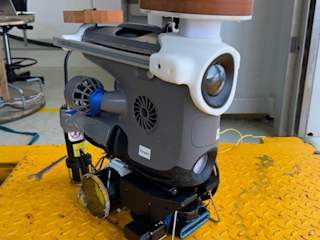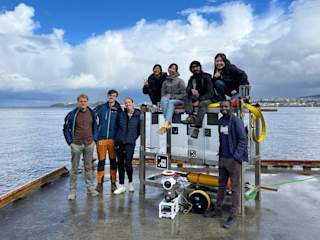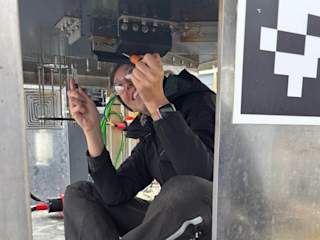But first, why is the Blueye ROV tethered?
Blueye ROVs are connected via a tether to ensure fast, stable, and reliable communication between the drone and the operator. The tether enables real-time data transmission directly to the surface, providing operators with live video and sensor data essential for precise and safe underwater maneuvering. In addition, control signals are sent down to the ROV through the same tether, allowing the operator to continuously adjust direction, speed and camera angle - ensuring full control of the drone at all times.
A tethered system also provides a simple setup, eliminating the need for complex wireless solutions or external base stations. The system is mobile and flexible - it can be used almost everywhere, whether from shore, a boat, or a dock.
The tether is connected to both the surface unit and the drone for fast and easy setup.
The tether also ensures stable power and signal transmission, delivering added reliability in demanding underwater environments.
Blueyes tether on reels are designed with durability and flexibility in mind, ensuring seamless performance with Blueye ROVs. The reel system allows for efficient storage and deployment, reducing wear and extending the tether's lifespan.
Available in standard lengths up to 250 meters, with options for customized lengths up to 500+ meters. Featuring an impressive breaking strength of 100 kg, they are well-suited for a wide range of underwater operations.
The tether also serves as a reliable safety measure. If the connection to the ROV is lost, it can always be manually retrieved by pulling it back via the tether.
NTNU PhD project aiming to make the Blueye ROV autonomous
Leonard Florian Tom Günzel is a PhD candidate at the Department of Marine Technology at the Norwegian University of Science and Technology (NTNU), and is currently leading a new project to make the Blueye ROVs autonomous. The goal of the project is to eliminate the tether connected to the Blueye Surface Unit and enable the ROV to operate independently from a docking station placed on the seafloor.
We’re working to turn Blueye into an autonomous underwater vehicle that can reside on the seafloor for extended periods." - Leonard Florian Tom Günzel, PhD candidate, NTNU.

Günzel has a background in maritime technology and electrical engineering, but his passion for robotics grew through several research assistant roles and internships at marine institutions around the world. During these periods, he gained experience with applied underwater robotics, image analysis and sensor development.
I’ve really enjoyed the freedom that research both requires and encourages, along with the challenge of pushing scientific boundaries with each project." - Leonard Florian Tom Günzel, PhD candidate, NTNU.
Through his work, Günzel has been able to combine two of his greatest passions: exploring the ocean and developing new technologies. Still, one major challenge continues to emerge — the vast and complex nature of the ocean. He explains that to understand large-scale ocean processes, researchers often have to repeatedly observe a small area and draw conclusions from that data. While this approach yields valuable insights, it remains limited in scale and comes with high costs. He believes the key lies in large-scale autonomous systems — robots that can move freely and continuously, providing us with a comprehensive, satellite-like perspective of the underwater world.
How do you make an ROV autonomous?
Günzel and the project team are working to ensure that the underwater drone, as it approaches the docking station, can either position itself in front of an optical modem for wireless data communication or go directly to docking. The docking station is designed to enable inductive charging and high-speed transfer of both measurement data and mission information. In this way, collected data can be transferred and new instructions uploaded, allowing the drone to be ready for its next mission - all while remaining underwater and without the need for human intervention. This makes it possible to have the underwater drone permanently stationed on the seafloor, always ready for the next task without needing to be brought up to the surface.
On a physical level, it’s surprisingly straightforward: you add computing power that can steer the robot instead of a human, cut the tether and just like that, your ROV becomes an AUV. But replacing the human decisions is where the real challenge lies." - Leonard Florian Tom Günzel, PhD candidate, NTNU.
There are many unforeseen situations a robot must be able to understand and handle. That is why the project team has deployed a tethered vehicle at a depth of 90 meters in the Trondheimfjord. This allows them to test algorithms in the actual environment they aim to operate in, while still maintaining the option for manual control if something goes wrong. One unexpected challenge the team could not simulate was that fish are often attracted to the lights and swim directly in front of the docking markers, blocking the robot’s view and interfering with navigation.

The Blueye X3 operating autonomously
After several months of simulations and system development, Günzel, together with PhD colleagues Ambjørn Waldum and Gabriele Kasparaviciute and eight master’s students, has now completed their first successful field operation in the Trondheim fjord. The field operation was carried out in collaboration with NTNU’s larger ROV, Minerva, and marks an important technological advancement in autonomous underwater systems. The test demonstrated for the first time that a compact ROV like the Blueye X3 can operate autonomously.
The project team has further developed both the underwater drone and the necessary infrastructure required for long-term autonomous underwater operations. This means the drone must be able to navigate accurately over distances ranging from 100 to 500 meters and return to a docking station placed on the seafloor. This involves the use of a USBL system (Ultra-Short Baseline), which communicates with a modem on the AUV. A USBL system combines multiple transducers to determine the direction and distance to an acoustic source.

In the case of this PhD project, where the goal is to develop autonomous capabilities, direct integration with the drone's control system is essential. Universities, researchers, and system integrators may need to embed the drone into larger systems or control it through third-party software. To support such use cases, Blueye provides an access points for control - the Blueye SDK. This SDK is open source, available on pypi.org, and enables developers and students to build custom control algorithms, automate missions, and explore new applications for underwater robotics.
Real-world conditions
Günzel explains that autonomy exists on a spectrum — even features like station keeping are considered a form of autonomy, as they allow the operator to focus on the task at hand without worrying about the vehicle drifting with the current. The first features the project team plans to implement will likely include autonomous docking and automated survey routines. In the longer term, they envision a system where the pilot no longer has direct control but instead acts as a supervisor, overseeing operations. These concepts are already being tested in real-world conditions, and they are beginning to see the first commercial applications take shape.

The testing phase has provided the project team with several valuable insights, one of the clearest being that handling failure is one of the biggest challenges in autonomy. To manage such situations, the robot needs what they refer to as situational awareness—the ability to interpret its surroundings and respond appropriately. This also calls for more adaptive mission planning tools that can react to real-world challenges in real time.
Several years of research
The project is part of the SAFEGUARD initiativ and builds on several years of research and development at NTNU. The NTNU VISTA Center for Autonomous Robotics Operations Subsea (CAROS) has played a central role in developing the necessary infrastructure and support systems.

Establishing a base at 90 meters depth is just the beginning. The project team hopes this will lay the foundation for future research, ranging from energy-efficient surveys and multi-robot coordination to recurring infrastructure inspections and full mission autonomy. Günzel is particularly excited to further explore situational awareness and perception, and as project manager, he looks forward to the next semester, when the goal is to finally cut the tether for good.
I’m incredibly thankful for everyone who contributed – through master’s theses, technical work, and ongoing support. And of course to Martin Ludvigsen, who laid much of the foundation for what we’re building on today." - Leonard Florian Tom Günzel, PhD candidate, NTNU.
He emphasizes that the project would not have been possible without a strong team. Ambjørn Waldum and Gabriele Kasparaviciute have been central throughout the process, and he highlights the contributions of master’s students Abubakar Aliyu Badawi, Celil Yılmaz, Mahmoud H. Abdelrazik Hassan, and Samin Yeaser, as well as design students Dana Yerbolat, Elena Marie Kirchman, Jenny Krokstad, and Ai-Nhi Hoang. He also extends his thanks to the engineering team at AURLab and gives special recognition to Martin Ludvigsen for laying the groundwork that made this possible, along with the SAFEGUARD project and the Department of Marine Technology for their continued support.




